Welcome to Segmentation, Targeting and Positioning. In this topic, you will learn about:
- Strategic planning:
- Creating and capturing customer value
- Buyer behaviours
- BCG Growth-Share matrix
- Product / market expansion grid
- Managing marketing strategy and marketing mix
- Segmentation: selecting customers to serve
- Benefits and requirements of effective segmentation
- Targeting: selecting customers to serve
- Positioning: market strategy creation
- Choosing a differentiation and positioning strategy
So far, we have discussed topics such as:
- creating and capturing customer value, the marketing process, the marketing system.
- marketing environments
- marketing analytics
- consumer behaviour
Now let us take this knowledge and build on it further by looking into:
- strategic planning
- BCG growth/share matrix and the PLC product life-cycle & the product/market expansion grid
- managing marketing strategy and the marketing mix
- segmentation, targeting and positioning.
Let us begin my revisiting the core marketing concepts, demonstrated in the following illustration.
Core marketing concepts
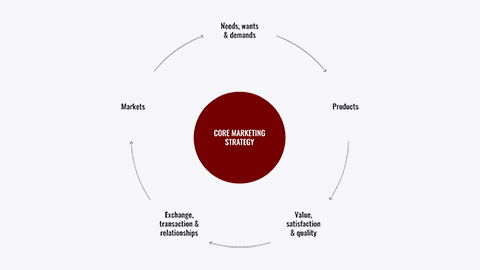
The marketing process: Creating and capturing customer value

This figure presents a simple, five-step model of the marketing process for creating and capturing customer value- marketing in a nutshell!
In the first four steps, companies work to understand consumers, create customer value, and build strong customer relationships. By creating value for customers, marketers capture value from customers in return. In the final step, companies reap the rewards of creating superior customer value, these rewards are in the form of sales, profits, and long-term customer equity.
An expanded model of the marketing process
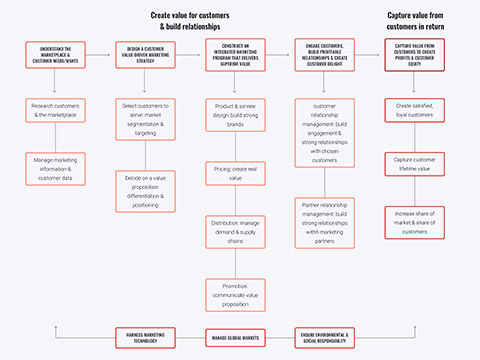
This figure represents a map for the entire marketing process., throughout this process, marketers practice customer relationship management to create customer satisfaction and delight.
In creating customer value and relationships, a firm must work closely with marketing partners both inside the company and throughout its marketing system. Therefore, beyond practising good customer relationship management, firms must also practice good partner relationship management.
A modern marketing system

Marketing involves serving a market of final consumers in the face of competitors, this image shows the main elements in a modern marketing system.
Each party in the system adds value for the next level, the arrows represent relationships that must be developed and managed, thus, a company’s success at building profitable relationships depends not only on its own actions but also on how well the entire system serves the needs of final consumers.
For example, a company cannot fulfil its promise of low prices unless its suppliers provide merchandise at low costs.
With this in mind, let us revisit a few key terms.
Value, satisfaction, and quality
- Customer value is the difference between the customer benefits from owning and/or using a product and the costs of obtaining the product
- Customer satisfaction is perceived value delivered relative to a buyer’s expectations
- Quality is the totality of features and characteristics of a product or service that bear on its ability to satisfy customer needs
Exchange, transactions, and relationship marketing
- Exchange is the act of obtaining a desired object from someone by offering something in return
- A transaction is marketing’s unit of measurement and consists of a trade of values between two parties
- Relationship marketing is building strong economic relationships between with social ties by following through on promises
Markets
A market is a set of actual and potential buyers who might transact with a seller
Actors in the microenvironment

This figure shows the major actors in the marketer’s microenvironment. Let us look at the flowing actors:
- The company – marketers must work in harmony with other company departments to create customer value and relationships.
- Suppliers – In creating value for customers, marketers must partner with the other firms in the company’s value delivery network.
- Customers - customers are the most important actors in the company’s microenvironment, the aim of the entire value delivery system is to serve target customers and create strong relationships with them.
Major forces in the company’s macroenvironment
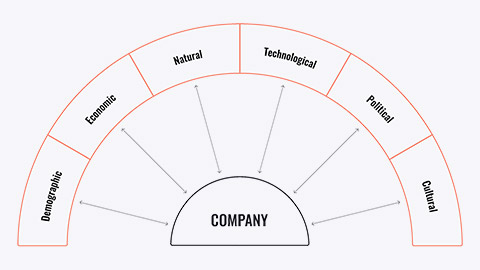
This figure shows the six major forces in the company’s macroenvironment.
For example, concern for the natural environment has spawned a so-called green movement which has seen companies such as Timberland focusing on products which do less harm to the environment. Marketers also want to be socially responsible citizens in their markets and communities, taking into consideration cultural forces in their marketing environment. This can be seen, for example, with Warby Parker, an American online eyewear seller which was founded on a cause: For every pair of their glasses sold, the company vows to provide a free pair to someone in need. Demographics is also a key concept for marketers to consider, as changing demographics means changes in markets and therefore market strategies. For example, Netflix created a “Just for Kids” portal and app, targeting today’s fast-growing young, tech-savvy “Gen-Z” segment.
The model of buyer behaviour
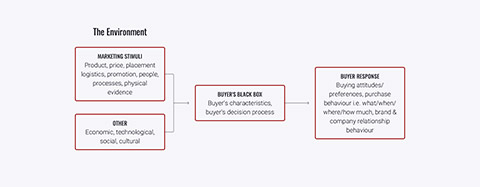
This figure shows that marketing and other stimuli enter the buyer’s “black box” (essentially, the buyer's thoughts) and, as a result, produce certain responses. The whats, wheres, and whens of consumer buying behaviour can be measured, but it’s very difficult to figure out the whys of buying behaviour (that’s why it’s called the black box).
In order to market effectively, a challenge marketers spend a lot of time and money trying to figure out, is what is in the buyer’s black box, what makes customers tick?
Factors influencing consumer behaviour

Consumer purchases are influenced strongly by both internal and external factors such as cultural, social, personal, and psychological characteristics as shown above, and, for the most part, marketers cannot control such factors, but they must take them into account. Let us now look further into customer needs.
Maslow’s Hierarchy of Needs and Related Products
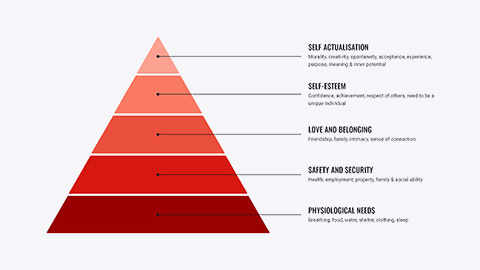
| Need | Relevant product | Example |
|---|---|---|
| Self-actualisation | Hobbies, travel, education | U.S. Army- "Be all you can be." |
| Ego | Cars, furniture, credit cards, stores, liquor | Royal Salute Scotch- "What the rich give the wealthy." |
| Social | Clothing, grooming products, clubs, drinks | Pepsi- "You're in the Pepsi generation." |
| Safety | Insurance, alarm systems, retirement, investments | Allstate Insurance- "You're in good hands with Allstate." |
| Psychosocial | Medicines, staple items, generics | Quaker Oat bran- "It's the right thing to do." |
Maslow’s hierarchy of needs categorizes buyer motivation as being related to five different types of needs which include physiological, safety, belongingness, ego, and self-actualization with the more pressing, fundamental needs at the bottom of the pyramid. Essentially, Maslow’s theory argues that humans have a series of needs, of which, consumers will seek to satisfy lower-level needs first( deemed as being more pressing / fundamental) (e.g., physiological) before progressing to higher-level needs.
In short, decision-making processes and human behaviour are largely influenced by one of Maslow’s five levels, therefor, with this in mind, in order to achieve effective marketing, marketers should understand the level of need most relevant to their consumer target enabling them to effectively tailor their product and messages to effectively appeal to one of these five motivational influences in their marketing process.
Steps in strategic planning
Let us pause and consider, with that we have learnt so far, the steps involved in strategic planning and some useful questions to ask ourselves when at each stage.

Define the mission
- What business are we in?
- What customers should we serve?
- How should we develop the firm's capabilities and focus it's efforts?
Evaluate internal/external environment
- Situation or environmental analysis: SWOT analysis
- Internal strengths and weaknesses
- external opportunities & threats.
Set organisational or SBU objectives
- Objectives should be specific, measurable, attainable and sustainable over time
- May relate to revenue/sales, profitability, market standing, ROI, product development, customer satisfaction etc.
Establish business portfolio
- Large firms often operate a range or different businesses (SBUs) that are called its business portfolio.
Develop growth strategies
- Portfolio analysis
- Assesses the growth potential for a firms' SBU's
- Guides decisions on allocation of corporate resources to different SBUs
- BCG Growth-share matrix is popular.
The best-known portfolio-planning method was developed by the Boston Consulting Group (BCG), a leading management consulting firm, the BCG Growth-Share matrix. This shows the classification of a company’s strategic business units (SBUs), where market growth rate provides a measure of market attractiveness and relative market share serves as a measure of company strength in the market.
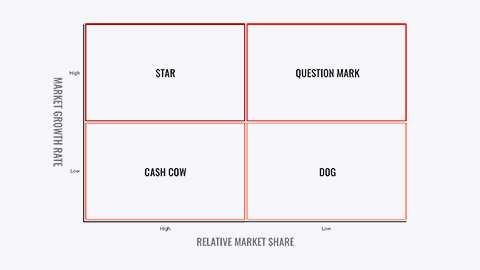
The Growth-Share Matrix defines four types of strategic business units (SBUs):
- Stars are high-growth, high-share businesses, or products.
- Cash cows are low-growth, high-share businesses, or products.
- Question marks are low-share business units in high-growth markets.
- Dogs are low-growth, low-share businesses, and products.
The ten circles in this growth-share matrix would represent a company’s ten current SBUs. The company must then decide how much it will invest in each product or business SBU as well as whether the company should build, hold, harvest or divest.
With this classic BCG portfolio planning approach, the company invests funds from mature, successful businesses and products ( cash cows) to support promising businesses and products in faster-growing markets ( stars and question marks) with the hope that they will turn into future cash cows.

Let us now look at examples of BCG matrixes of some well-known companies and their products.
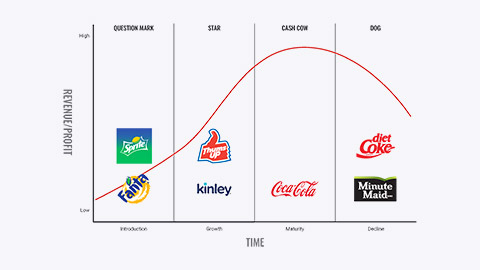
Unilever BCG matrix
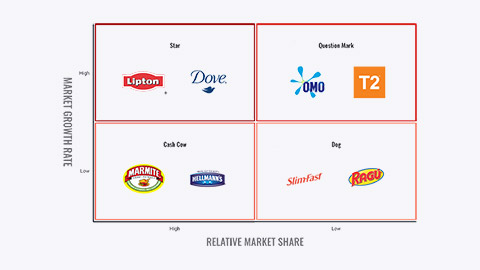
Problems with Growth-Share Matrix
So, whilst there are benefits with this model, let us be aware of some problems with the Growth-share matrix.
- Difficult, time-consuming, and costly
- Difficult to define and measure
- Provides little advice for future planning
The product/market expansion grid refers to a portfolio-planning tool for identifying company growth opportunities through market penetration, market development, product development, or diversification.
Companies must first consider if they can achieve deeper market penetration, that is, make more sales to current customers without changing the original products. Second, companies must consider possibilities for market development, such as expanding into new countries, this refers to identifying and developing new markets for its current products. Thirdly, companies could consider product development by offering modified or new products to current markets. Finally, companies might consider diversification, which refers to starting up or buying businesses beyond the firm’s current products and markets. Through diversification, companies can grow by starting up or buying businesses outside their current products/markets.

In only three decades, Starbucks has grown at an astounding pace from a small Seattle coffee shop to an over $22 billion powerhouse with more than 27,000 retail stores in more than 75 countries.

Downsizing
Companies must not only develop strategies for growing their business portfolios but also strategies for downsizing them. When a firm finds brands or businesses that are unprofitable or that no longer fit its overall strategy, it must carefully prune, harvest, or divest them.
There are many reasons that a firm might want to abandon products or markets, for example:
- the firm may have grown too fast or entered areas where it lacks experience
- the market environment might change, making some products or markets less profitable, for example, in difficult economic times, many firms prune out weaker, less-profitable products and markets to focus their more limited resources on the strongest ones.
- finally, some products or business units simply age and die.
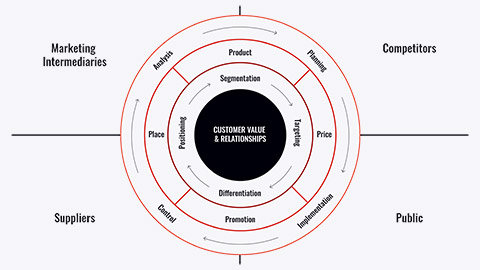
Marketing strategy involves two key questions:
- Which customers will we serve (segmentation and targeting)?
- How will we create value for them (differentiation and positioning)?
Then the company designs a marketing program—the four Ps—that delivers the intended value to targeted consumers.
At its core, marketing is all about creating customer value and profitable customer relationships.
Customer value-driven marketing strategy
The strategic plan defines the company’s overall mission and objectives. Thus, the marketing strategy refers to the marketing logic by which the company hopes to create customer value and achieve profitable customer relationships. Guided by said marketing strategy, the company designs an integrated marketing mix made up of factors under its control, which are product, price, place, and promotion.
To find the best marketing strategy and mix, the company engages in marketing analysis, planning, implementation, and control and it is through these activities, the company watches and adapts to the factors and forces in the marketing environment.
Let us now look at marketing segmentation and targeting.
Marketing segmentation and targeting
Market segmentation refers to dividing a market into distinct groups of buyers who have different needs, characteristics, or behaviours, and who might require separate products or marketing programs.
A market segment is a group of consumers who respond in a similar way to a given set of marketing efforts. In the car market, for example, consumers who want the biggest, most comfortable car regardless of price, make up one market segment whereas consumers who care mainly about price and operating economy, make up another segment.
Market targeting involves evaluating each market segment’s attractiveness and selecting one or more segments to enter. A company should target segments in which it can profitably generate the greatest customer value and sustain it over time.
Market differentiation and positioning
After a company has decided which market segments to enter, it must determine how to differentiate its market offering for each targeted segment and what positions it wants to occupy in those segments.
Positioning refers to arranging for a product to occupy a clear, distinctive, and desirable place relative to competing products in the minds of target consumers.
Effective positioning begins with differentiation. This refers to actually differentiating the market offering to create superior customer value. Once the company has chosen a desired position, it must take strong steps to deliver and communicate that position to target consumers. The company’s entire marketing program should support the chosen positioning strategy. For example, Uber positions itself as “Everyone’s private driver”, this simple statement provides the backbone for its marketing strategy.

The four Ps of the marketing mix
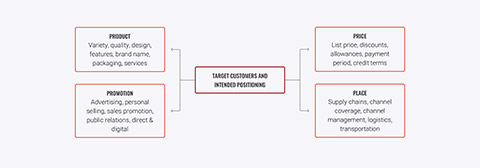
The marketing mix is the set of tactical marketing tools that the firm blends to produce the response it wants in the target market, let us revisit the four marketing tools, the four Ps.
- Product is the goods-and-services combination the company offers to the target market.
- Price is the amount of money customers must pay to obtain the product.
- Place includes the company activities that make the product available to target consumers.
- Promotion refers to activities that communicate the merits of the product and persuade target customers to buy it.
An effective marketing program blends the marketing mix elements into an integrated marketing program designed to achieve the company’s marketing objectives by delivering value to consumers.
SWOT analysis
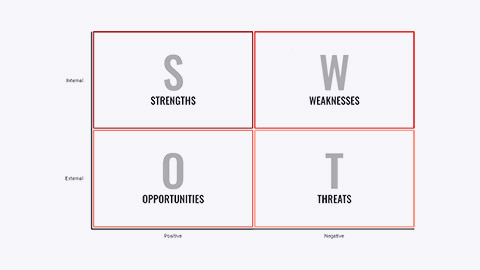
Managing the marketing function begins with a complete analysis of the company’s situation. The marketer should conduct a SWOT Analysis, with the goal being to match the company's strengths to attractive opportunities in the environment while overcoming or eliminating the weaknesses and minimizing the threats. During this process, an overall evaluation of the company’s strengths (S), weaknesses (W), opportunities (O), and threats (T) should be conducted.
The SWOT tool is a key tool in the marketer’s toolkit, this will be called on often in your career, especially when analysing business cases, let us take a look at the components below:
- strengths include internal capabilities, resources, and positive situational factors that may help the company serve its customers and achieve its objectives.
- weaknesses include internal limitations and negative situational factors that may interfere with the company’s performance.
- opportunities are positive factors or trends in the external environment that the company may be able to exploit to its advantage.
- threats are negative external factors or trends that may present challenges to performance.
Contents of a marketing plan
Let us now combine what we know and add to our tool kit with adding to our marketing plan. Take a look at the information below which discusses the different sections to include and the purpose they serve to you and other stakeholders in the marketing process.
| Section | Purpose |
|---|---|
| Executive summary | Brief summary of the main goals and recommendations |
| Current marketing situation | Gives the market description and the product, competition, and distribution review |
| Threats and opportunities analysis | Helps management to anticipate important positive or negative developments |
| Objectives and issues | States and discusses marketing objectives and key issues |

Segmentation, targeting, and positioning (STP) is a familiar and commonly applied approach in today’s modern marketing world with the key difference to previous marketing models which focused on the product, STP focuses on the customer, the company’s key audience. The STP model is beneficial also as the focus of this model, in line with customers, is commercial effectiveness, i.e. selecting the most valuable segments for the business, and then proceeding to develop a marketing mix and positioning strategy for each selected segment.
Let us begin by looking at what occurs within these stages.
Segmentation
In this stage, the marketer and relevant members should identify bases for segmentation, essentially grouping customers into groups based on similar needs and determining important characteristics of each segment.
Targeting
Here, is it important to then evaluate the attractiveness, both potential and commercial attractiveness, of each segment and then proceed to selecting one or more segments.
Positioning
In this stage, it is important to develop a thorough, relevant value proposition for each target segment and then create a marketing mix for each chosen segment, building an action plan.
Major segmentation variables for consumer markets

Let us now consider the major segmentation variables in the consumer market. The following table outlines variables that might be used in segmenting consumer markets, these are considered five bases for segmentation.
| Geographic | County, region, city, urban/rural, climate |
|---|---|
| Demographics | Age, income, gender, generation, martial status, family size, occupation, education, ethnicity, religion |
| Psychographics | Lifestyle, personality, activities, interests, opinions |
| Behavioural | Usage rate, loyalty, product knowledge, involvement, purchase occasion, buying stage |
| Other | Convenience, value, safety, status |
Let us look at each of these in more detail.
Geographic segmentation
Geographic segmentation calls for dividing the market into different geographical units, such as nations, regions, states, counties, cities, or even neighbourhoods. For example, many large retailers are now opening smaller format stores designed to fit the needs of densely packed urban neighbourhoods not suited to their typical large suburban superstores.
Demographic segmentation
Demographic segmentation divides the market into segments based on variables such as age, life-cycle stage, gender, income, occupation, education, religion, ethnicity, and generation. Demographic factors are the most popular basis for segmenting customer groups. These factors are discussed in detail below.
Age and life-cycle segmentation
- Some companies use age and life-cycle segmentation, offering different products or using different marketing approaches for different age and life-cycle groups.
Gender segmentation
- Gender segmentation divides a market into different segments based on gender, and has long been used in marketing clothing, cosmetics, toiletries, toys, and magazines For example, the men’s personal care industry has exploded, and many cosmetics brands that previously catered mostly to women, now successfully market men’s lines.
Income segmentation
- Dividing a market into different income segments
Psychographic segmentation
People in the same demographic group can have very different psychographic characteristics, with this in mind, marketers segment their markets using variables such as:
- Social class
- Lifestyle
- Personality characteristics
Essentially, the products people buy reflect their lifestyles.
Behavioural segmentation
Many marketers believe that behaviour variables are the best starting point for building market segments.
Occasion segmentation
Here the market is divided into segments according to occasions when buyers get the idea to buy, actually make their purchase, or use the purchased item. This segmentation can help firms build up product usage. Companies try to boost consumption by promoting usage during nontraditional occasions. For example, most consumers drink orange juice in the morning, but orange growers have promoted drinking orange juice as a cool, healthful refresher at other times of the day.
Benefit segmentation
Segments are divided according to the different benefits that consumers seek from the product.
| User Status | Usage Rate | Loyalty Status |
|---|---|---|
| Market segmented into: non-users, ex-users, potential users, first-time users, regular users | Markets segmented into: light, medium, heavy product users | Consumers loyal to: brands, stores, companies. |
User status segments markets into nonusers, ex-users, potential users, first-time users, and regular users of a product. Marketers want to reinforce and retain regular users, attract targeted nonusers, and reinvigorate relationships with ex-users. Included in the potential user's group are consumers facing life-stage changes who can be turned into heavy users.
Usage rate segments markets into light, medium, and heavy product users. Heavy users are often a small percentage of the market but account for a high percentage of total consumption.
A market can also be segmented by loyalty status. Consumers can be loyal to brands, stores, and companies. Highly loyal customers promote the brand through personal word of mouth and social media. In contrast, by studying its less-loyal buyers, a company can detect which brands are most competitive with its own. By looking at customers who are shifting away from its brand, the company can learn about its marketing weaknesses and take actions to correct them.
For example, Fitbit “There’s a Fitbit for everyone”

In summary, marketers and their team(s) should ask themselves the following questions:
Why: why do customers make the decisions they do? Are they based on their needs and or preferences? What is there decision process?
What: what have the customers done? Reflecting and analysing on factors such as usage, loyalty and profitability.
Who: who are the customers? Their demographics, media habits and lifestyles.
For example, take a look at six segments of millennials:
| Hip-ennial | "I can make the world a better place." |
|
| Gadget guru | "It's a great day to be me." |
|
| Millennial Mum | "I love to work out, travel, and pamper my baby." |
|
| Clean and green millennial | "I take care of myself and the world around me." |
|
| Anti-millennial | "I'm too busy taking care of my business and my family to worry about much else." |
|
| Old-school millennial | "Connecting on Facebook is too impersonal. Let's meet up for a coffee instead." |
|
Finding the right market segment for low rise jeans
Look at the following Venn diagram which illustrates, planning and identification of target markets, their demographics, and bases for segmentation, enabling the marketer the ability for more accurately determining relevant marketing approaches.
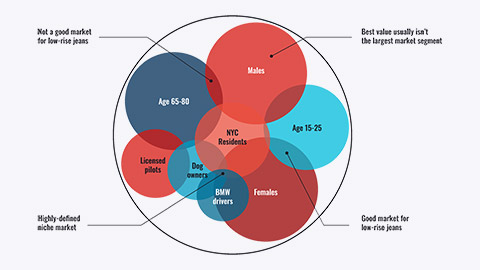
Selecting target segments
Look at the following diagram which highlights factors to consider when selecting target segments, taking into consideration factors such as, competition, characteristics of each segment and the overall fit in line with the company.

Why perform market segmentation? Take a look at the following benefits to both the organisation and the customer(s).
Benefits to the organisation
These include but are not limited to:
- identifying any unfulfilled needs
- improving product design
- creating more targeted promotions
- increasing customer
These factors typically resulting in sustainable profit growth.
Benefits to the customer
- convenience and time savings
- tailored products and services
- receiving relevant offers
- enjoying a personalised experience.
These factors typically resulting in compelling customer experience.
Requirements for effective segmentation
In order to be useful, market segments should be:
- Measurable: the size, purchasing power, and profiles of market segments should be measurable.
- Accessible: the market segments must be accessible – effectively reached and served.
- Substantial: the market segments should be substantial – large or profitable enough to serve.
- Differentiable: they should be differentiable, which means they are conceptually distinguishable and respond differently to different marketing mix elements and programs.
- Actionable: finally, the segments should be actionable, which means that effective programs can be designed for attracting and serving the segments.
Let us look a little closer at each of these.
The size, purchasing power, and profiles of the segments can be measured. For example, 700 million left-handed people around the world, huge hypothetical market, right? How many products for lefties have you seen sold and /or advertised? The major problem may be that the segment is hard to identify and measure.
There is no data on the demographics of lefties in any Census Bureau anywhere in the world, because it is not asked in census surveys. Private data companies keep reams of statistics on other demographic segments but not on left-handers.
The market segments must be effectively reached and served. Suppose a fragrance company finds that heavy users of its brand are single men and women who stay out late and socialize a lot, unless this group lives or shops at certain places and is exposed to certain media, its members will be difficult to reach.
The market segments are large enough or profitable enough to serve. A segment should be the largest possible homogeneous group worth pursuing with a tailored marketing program. It would not pay, for example, for an automobile manufacturer to develop cars especially for people whose height is greater than seven feet.
The segments are conceptually distinguishable and respond differently to different marketing mix elements and programs, i.e. If men and women respond similarly to marketing efforts for smart phones, they do not constitute separate segments.
Effective programs can be designed for attracting and serving the segments. For example, although one small airline identified seven market segments, its staff was too small to develop separate marketing programs for each segment.
Market segmentation reveals the firm’s market segment opportunities, the firm must then evaluate the various segments and decide how many and which segments it can serve best. In evaluating different market segments, a firm must look at three factors.
First, a company wants to select segments that have the right size and growth characteristics. Second, the company needs to examine major structural factors that affect long-run segment attractiveness like strong and aggressive competitors or if it is easy for new entrants to come into the segment. The existence of actual or potential substitute products, the relative power of buyers, and powerful suppliers also affects segment attractiveness. Thirdly and finally, the company must consider its own objectives and resources. Some attractive segments can be dismissed quickly because they do not mesh with the company’s long-run objectives or the company may lack the skills and resources needed to succeed in an attractive segment.
After evaluating different segments, the company must decide which and how many segments it will target. A target market consists of a set of buyers who share common needs or characteristics that the company decides to serve. Market targeting can be carried out at several different levels.
Market-targeting strategies

This figure shows that companies can target very broadly, very narrowly, or somewhere in between.
- Undifferentiated (or mass marketing)
- refers to a market-coverage strategy in which a firm decides to ignore market segment differences and go after the whole market with one offer.
- Differentiated (or segmented marketing)
- refers to a market-coverage strategy in which a firm decides to target several market segments and designs separate offers for each.
- Concentrated (or niche marketing)
- refers to a market-coverage strategy in which a firm goes after a large share of one or a few smaller segments or niches.
- Micromarketing
- is the practice of tailoring products and marketing programs to suit the tastes of specific individuals and locations. Rather than seeing a customer in every individual, micro marketers see the individual in every customer.
- Micromarketing includes local marketing and individual marketing. Local marketing involves tailoring brands and marketing to the needs and wants of local customer segments like cities, neighbourhoods, and even specific stores. Individual marketing involves tailoring products and marketing programs to the needs and preferences of individual customers, for example, M&M’s invite their customers to their webpage where they can design their own M&M’s with a personalised message or a picture of their face on each individual M&M.
- Mass customization is the process by which firms interact one to one with masses of customers to design products, services, and marketing programs tailor-made to individual needs.
Example of market targeting
Using a differentiated marketing (or segmented marketing) strategy, a firm decides to target several market segments and designs separate offers for each, servicing even narrower niches. For example, Proctor and Gamble (P&G) markets at least six different laundry detergent brands in the United States (Tide, Gain, Cheer, Era, Dreft, and Bold), which compete with each other on supermarket shelves. Thanks to its differentiated approach, P&G is really cleaning up in the $15 billion U.S. laundry detergent market, capturing a 61 percent market share.
Choosing a targeting strategy
Companies need to consider many factors when choosing a market-targeting strategy, which strategy is best is dependent upon the company’s resources. When the firm’s resources are limited, concentrated marketing makes the most sense. The best strategy also depends on the degree of product variability, therefor the product’s life-cycle stage also must be considered. When a firm introduces a new product, it may be practical to launch one version only and performing undifferentiated marketing or concentrated marketing may make the most sense. In the mature stage of the product life cycle, however, differentiated marketing can be useful.
Another factor is market variability, if most buyers have the same tastes, buy the same amounts, and react the same way to marketing efforts, undifferentiated marketing is appropriate. Finally, competitors’ marketing strategies are important to consider when choosing an appropriate marketing strategy, when competitors use differentiated or concentrated marketing, undifferentiated marketing can be suicidal.
Socially responsible target marketing
Target marketing sometimes generates controversy and concern. The biggest issues usually involve the targeting of vulnerable or disadvantaged consumers with controversial or potentially harmful products. In target marketing, the issue is not really who is targeted but rather how and for what. Controversies arise when marketers attempt to profit at the expense of targeted segments—when they unfairly target vulnerable segments or target them with questionable products or tactics. For example, McDonald’s and chains have drawn criticism for pitching their high-fat, salt-laden fare to low-income, urban residents who are much more likely than are suburbanites to be heavy consumers.
Socially responsible target marketing should be done to serve both the interests of the company and the interests of those targeted.
Colgate makes a large selection of toothbrushes and toothpaste flavours and packages for children, from Colgate Barbie Sparkling Bubble Fruit, Colgate Bernie Mild Fruit, and Colgate Looney Tunes Tazmanian Devil Wild Mint Toothpastes to Colgate Pokemon and Disney Monsters, Inc. character toothbrushes. Such products help to make tooth brushing more fun and get kids to brush more often and longer.
Let us now look at designing a customer value-driven market strategy, the following figure shows the four major steps in designing a customer-driven marketing strategy.
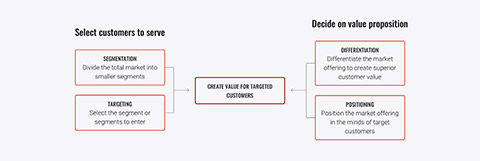
In the first two steps, the company selects the customers that it will serve. As we have just discussed, market segmentation involves dividing a market into smaller segments of buyers with distinct needs, characteristics, or behaviours that might require separate marketing strategies or mixes. Market targeting (or targeting) consists of evaluating each market segment’s attractiveness and selecting one or more market segments to enter.
In the final two steps, the company decides on a value proposition:
- Differentiation involves actually differentiating the firm’s market offering to create superior customer value.
- Positioning consists of arranging for a market offering to occupy a clear, distinctive, and desirable place, relative to competing products in the minds of target consumers.
Let us look further into these final two steps involved in market strategy creation.
Differentiation and positioning
Beyond deciding which segments of the market it will target, the company must also decide on a value proposition—how it will create differentiated value for targeted segments and what positions it wants to occupy in those segments?
A product position is the way a product is defined by consumers on important attributes—the place the product occupies in consumers’ minds relative to competing products.

Sonos, for example, does more than just sell speakers; it unleashes “All the music on earth, in every room of your house, wirelessly.”
Steps in positioning
The following image illustrates the steps involved within positioning.

Let us look at each of these stages in a little more detail.
Step 1: Analyze competitor’s positions
The first stage in developing a positioning strategy (or repositioning strategy) is to analyze the positions held by competitors. This is important, because if a competitive brand is already strongly associated with a particular benefit or advantage, it will be difficult to convince consumers to perceive your brand as being superior with respect to the same benefit or advantage, unless you have compelling proof.
In addition to analyzing how direct competitors are positioned, it is also important to analyze the positions of indirect competitors, that being those who provide similar benefits but often compete in different product categories. For example, if marketers of a soft drink beverage are considering positioning the product on the basis of its ability to quench thirst, they would analyze not only other soft drinks, but other beverages in general including bottled water, sports drinks, teas, lemonade products, etc.
Step 2: Define your competitive advantage
The second step requires that the marketer define and select a specific competitive advantage to use in the positioning strategy. Competitive advantages are desired because they demonstrate the brand’s superiority over the competition and give consumers a reason to buy the brand. However, to be effective as a positioning strategy, the particular competitive advantage chosen must be important to consumers, and ideally, relate to the primary benefits of the product. A more prestigious image, better quality product, superior warranty, or better customer service are just some of the competitive advantages which may be valued by consumers for many types of products. Competitive advantages which are based on price (lower price) are generally not sustainable, unless lower prices stem from truly lower costs which are realized due to efficiencies in the production process or cheaper access to raw materials which the competition cannot match.
Step 3: Finalize the marketing mix
Once a competitive advantage has been identified and selected as the basis of the positioning strategy, the marketing mix is adapted as necessary. The brand’s positioning strategy should come through clearly in all marketing communications, and the product itself must provide the benefits promised at a price the consumer is willing to pay. Finally, the product must be made available in locations where consumers shop.
Step 4: Evaluate responses and modify as needed
After implementation of the positioning strategy, it is important that marketers conduct or commission market research to ascertain whether or not consumers are actually perceiving the product in the same way that marketers intended. If not, the marketing mix needs to be adapted or the positioning strategy needs to be changed. Over time, even successfully positioned products may need to change their positioning strategy.
Position mapping
Marketers prepare perceptual positioning maps that show consumer perceptions of their brands versus those of competing products on important buying dimensions to plan their differentiation and positioning strategies. Positioning maps show consumer perceptions of their brands versus competing products on important buying dimensions.
This figure shows a positioning map for the U.S. large luxury SUV market. The position of each circle on the map indicates the brand’s perceived positioning on two dimensions: price and orientation (luxury versus performance). The size of each circle indicates the brand’s relative market share.
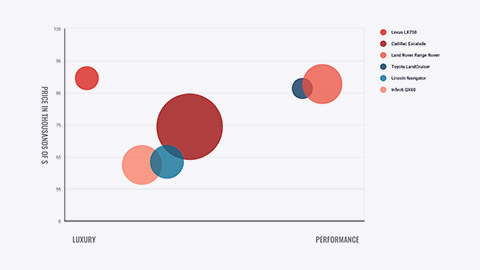

The creation of a differentiation and positioning strategy consists of three steps, which include identifying a set of differentiating competitive advantages on which to build a position, choosing the right competitive advantages, and selecting an overall positioning strategy. Then, the company must then effectively communicate and deliver the chosen position to the market.
Let us look at each of these steps in greater detail.
Identifying possible value differences and competitive advantages
Competitive advantage refers to an advantage over competitors gained by offering greater customer value, either by having lower prices or providing more benefits that justify higher prices.
To find points of differentiation, marketers must think through the customer’s entire experience with the company’s product or service. Through product differentiation, brands can be differentiated on features, performance, or style and design, some companies gain services differentiation through speedy, convenient service.
Firms that practice channel differentiation gain competitive advantage through the way they design their channel’s coverage, expertise, and performance. Companies can also gain a strong competitive advantage through people differentiation that is, hiring and training better people than their competitors.
Even when competing offers look the same, buyers may perceive a difference based on company or brand image differentiation. A company or brand image should convey a product’s distinctive benefits and positioning.
Competitive advantage and position strategy selection
Your value proposition is a cost vs. benefits formula that is evaluated subconsciously and automatically in your prospect’s mind when they encounter your marketing touchpoint. Think of this as an equation, balancing the perceived benefits and perceived cost of transacting with your brand. If your perceived benefits outweigh the perceived costs, your prospects will be motivated to act- note the word “perceived.”
It’s very important to understand customer segmentation as your benefits hold different weight for different people, therefor you need to find out which of your benefits are perceived to be most important to your unique prospects.
Motivation = Perceived benefits - Perceived costs
Let us look at Netflix for example.
What do they do? They let you watch movies and TV shows.
How do they do it differently? They make them available anytime, anywhere (for as little as $7.99 a month.)
They may not overtly state who they are serving, but in the case of the all-inclusive entertainment industry, they can effectively get away with it. Nice job, Netflix!
Communicating and delivering the chosen position
Once it has chosen a position, the company must take strong steps to deliver and communicate the desired position to its target consumers. All the company’s marketing mix efforts must support the positioning strategy. Companies often find it easier to come up with a good positioning strategy than to implement it.
Once a company has built the desired position, it must then take care to maintain the position through consistent performance and communication.
It must closely monitor and adapt the position over time to match changes in consumer needs and competitors’ strategies. A product’s position should evolve gradually as it adapts to the ever-changing marketing environment.
What’s in it for me?
The WIIFM are all the features and benefits your prospects could get from your products and services, however, you can’t communicate them all at once, if you try to emphasize everything, you’ll say nothing. With this being said, by testing, you should be able to arrive at the best value proposition. In essence, in order to find out what works best, you need to create great value proposition hypotheses to test and validate. Part of the marketers tool kit should be advanced Value Proposition optimisation, take a look at the following image which highlights where marketing considerations overlap and assist in value proposition creation and adjustment in the effort to destroy your competition. Let us look at these overlaps in more detail below.
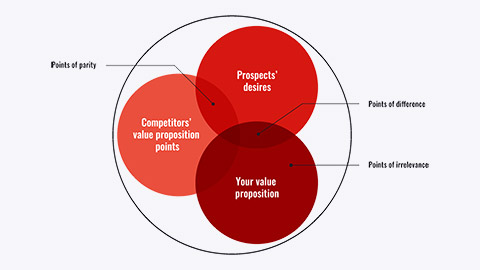
Points of Parity (POPs): These are the features you offer which are important to your prospects, that you also share with your competitors. Most marketers spend their time here, loudly trumpeting how they can do what their competitors can do too, only “better”! That’s a strategy to fail!
Points of Difference (PODs): Here’s where you can win the game. These are the features that are important to your prospects and not available from your competitors. Your PODs are where you should focus. These are the features you can emphasize that will move your prospects to action, they are your differentiators! You can use your PODs to destroy your competition.
Points of Irrelevance (POIs): You may have spent a lot of effort developing great features, but if nobody wants them, you should disregard them.
Nike started their products with a focus on performance and innovation with their mission statement reflecting the image they wish to create for their brand “To bring inspiration and innovation to every athlete in the world. If you have a body, you are an athlete” ("About Nike", 2020). Nike’s brand is focused on the concept of innovation for serious athletes to help you perform at your best every single time.
With these key messages in mind both Nike’s branding and messaging are both aligned, focusing on empowerment, from their tagline “Just Do It” to their name “Nike” which means the Greek Goddess of Victory.
They invented the waffle shoe and built their brand targeting serious athletes and have since expanded their product offerings beyond shoes, offering athletic attire that enhances performance. Their models and athletes are not smiling and happy, they are doing physical activities with their game faces on.
Take a look at the following ads which have been created by Nike over the years and consider the message and image it is attempting to portray and to which customers they may be targeting.
End of topic forum
There are forum activities for this topic. Select the ‘Forum’ at the end of your module (which can be found within your navigation menu) and follow the instructions for each question pertaining to 5 within the forum.
Take time to read through the following articles and videos on two well known companies.
Spacex
SpaceX’s adaptation to market changes
Elon Musk's Manned SpaceX Launch Makes the Space Business Serious
Levis
Read further about Levi’s value and company mission by visiting Levi Strauss & Co.
Blog discussion focusing on Levi’s market positioning, customer insights and their competitors.
The simple mantra that helped Levi’s turn its business around

